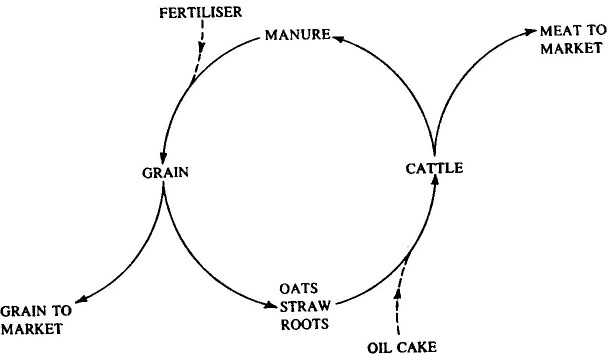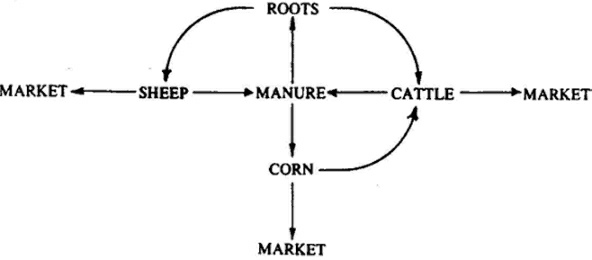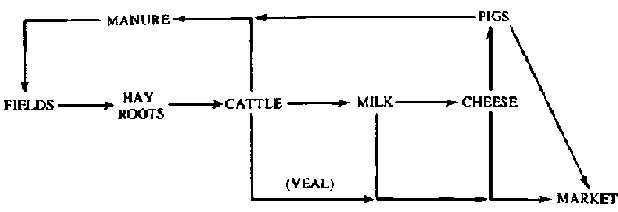


Manuring.
It is illuminating to reflect on a simple observation of the impact of cattle dung on plant growth. The picture below shows that only the meanest observational powers are needed to spot the enhanced meadow growth, in early spring, where cattle have been kept.. In fact a sing le cow can deposit about 25kg of dung a day!
le cow can deposit about 25kg of dung a day!
While domestication enhances the probability of observing this type of effect, there is no reason why it should not have been recognised earlier.What domestication does is to concentrate excrement, even to the extent where its disposal might represent a nuisance. Finding the material to have a value proves a bonus.
There is some etymological evidence for the above type of observation, about the effect of dung on grass growth. from the Old Norse word tath. This means both the heap of dung and the coarse grasses that grow from that heap. Just how far back in time Old Norse can be taken to represent is open to debate but it is likely to have been around before the Iron Age.
In contrast with animal manure, sources of plant manure are less certain and evidence from long ago is not easily recognisable, if at all. The only clear sources of plant manure (until composting was introduced) are likely to be adventitious, ploughing in of plant residues (stubble etc.) or weeds and rotting down of surface litter from hoeing or hand weeding.
Ancient practices are unlikely to mimic in any detail the sort of planned, systematic cycles used in Britain, over the last few centuries in a variety of different farming contexts, as illustrated below (abstracted from Barnwell and Giles 1997). In other words, it is unclear how integrated the activities of early farmers may have been, though some pieces of evidence are considered later.

1. A simplified mixed farming cycle from South Lincolnshire, UK

2. A simplified mixed farming cycle from North Nothumbe rland, UK
rland, UK
3. A simplified dairy farming cycle from Central Cheshire, UK
What is known, for example in Continental Europe, is that data from long houses indicates that livestock were kept at one end but drainage channels were a feature found much later than the Iron Age. In the UK, there is evidence that cattle were penned in dedicated enclosures. A Bronze Age cow house at Jarlshof (Trow-
In order to understand better how these different cycles influenced the recent building layouts and relative dispositions, including the incorporation of middens for holding and maturing the manure, it is recommended to read Barnwell and Giles in depth. This will develop a sound appreciation of the difficulties and procedures to be adopted, when seeking to reverse the principles to interpret archaeological information.
For animals other than cattle, Ryder (in Mercer 1981) pointed to the effects of run-
It is widely recognised that the penning of sheep and goats leads to some benefits to their grazing areas and that collection of dung may be an associated activity. Rowley-
Fenton (in Mercer) has drawn an association between wood ash, from various activities, in the context of early manuring practices. Hedge (1997) made a similar point in respect of urban disposal of fire ashes (both wood and coal/coke) as a soil improver, when exploring the contexts where wood ash could be found in use.
It can be seen then, that there has been much discussion and debate about the origins of manuring practices. A measure of both ethnographic and archaeological evidence leads to the conclusion that Iron Age peoples certainly had the means and opportunity to practice manuring, to enhance cropping. There is always likely to be some doubt, however, as to exactly what practices were adopted.
When it comes to designing experiments, it is clear that the exact details of when and how manure is applied can lead to interactions with both or either Ploughing and Hoeing. Thus it is essential to determine and prepare precise prescriptions, to ensure that data can be interpreted.
Only limited publication of Butser data on this topic has been attempted, usually to illustrate the size of the effect, which is fairly pronounced (Reynolds in Mercer 1981).
References
Barnwell P.S. and Giles, Colum "English Farmsteads 1750 -
Hedge R.W. "The Discovery and Prehistory of Soap" Butser Monograph No 2 1997
Mercer, Roger (ed.) "Farming Practices in British Prehistory" Edinburgh University Press 1981
Reynolds P.J. "Deadstock and Livestock" in Mercer 1981
Trow-